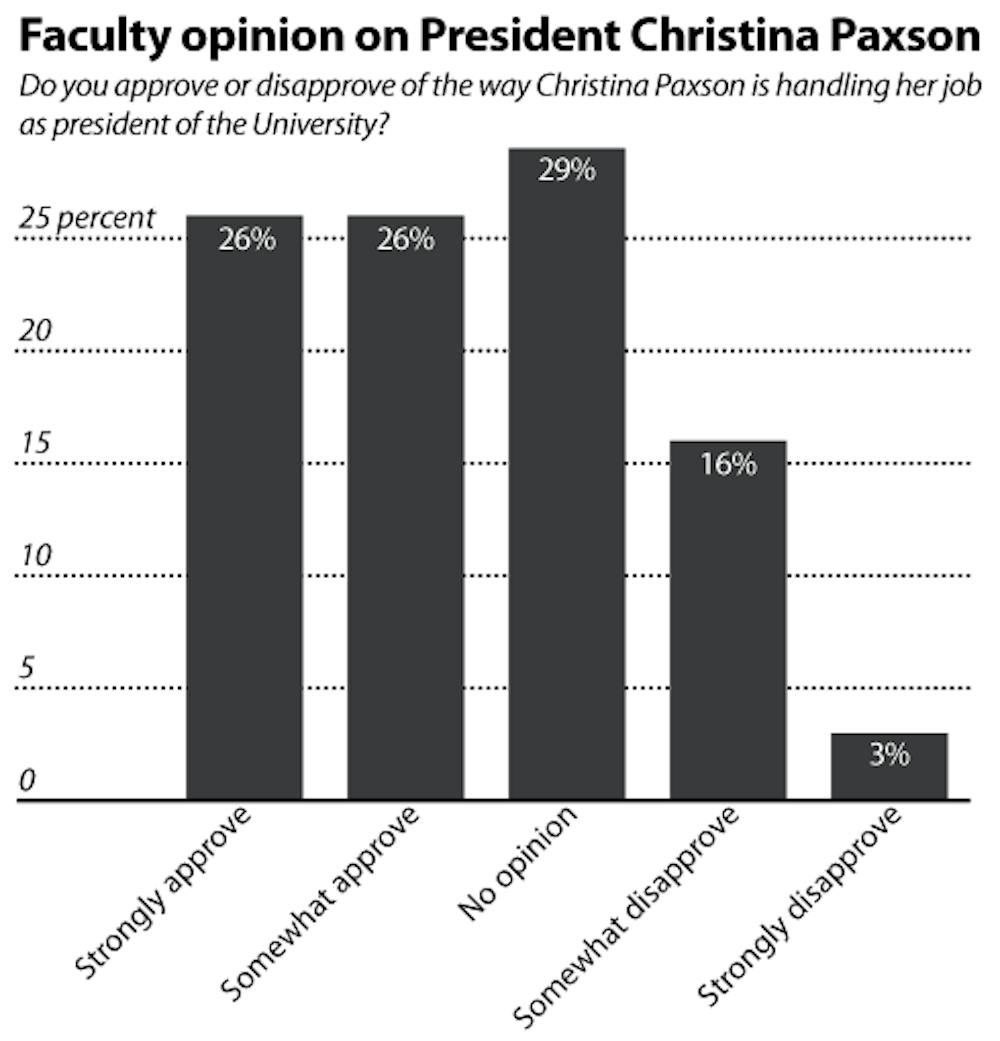Just over half of faculty members approve of President Christina Paxson’s job performance, while the share of faculty members who disapprove has increased from last spring, according to the results of a Herald poll conducted April 14-18.
Almost 20 percent of the faculty disapproves of Paxson’s handling of her job, with 16 percent somewhat disapproving and 3 percent strongly disapproving. Last year, only 4 percent of the faculty expressed disapproval. Roughly 26 percent strongly approve and 26 percent somewhat approve.
About 29 percent expressed no opinion. Last year, about 66 percent approved, while 30 percent had no opinion.
Roughly 40 percent of respondents indicated they strongly or somewhat approve of the Corporation’s handling of its job. This marks a substantial decrease from last spring, when roughly 60 percent of the faculty indicated approval. Twenty-two percent of the faculty strongly or somewhat disapprove of the Corporation’s job performance, compared to 16 percent one year ago.
The declines in faculty approval of both Paxson and the Corporation come after a series of controversial events last fall, including the shutdown of a lecture by former New York City Police Commissioner Ray Kelly and the Corporation’s decision not to divest from major fossil fuel companies.
About 41 percent of faculty poll respondents indicated that they believe the students who caused the shutdown of Kelly’s lecture should not receive any disciplinary action. Roughly 59 percent believe the students involved should receive disciplinary action, but were divided on what these actions should be. Seven percent believe the students should be expelled or suspended, while 17 percent believe they should be put on probation and 35 percent favor a lesser degree of disciplinary action.
Approval of the Faculty Executive Committee’s handling of its job also decreased since last spring, with about half of the faculty expressing approval, compared to 60 percent last year. Another 42 percent indicated no opinion of the committee’s performance, while 9 percent indicated strong or moderate disapproval.
Expanding financial aid emerged as a leading priority for faculty members, with roughly 47 percent of respondents indicating this should be one of the University’s top three priorities in the coming years.
Strengthening research and improving undergraduate teaching are also strong faculty member priorities, according to the poll — about 40 percent of respondents included one of those options among their top three. About 32 percent indicated that the University should make more opportunities for interdisciplinary collaboration a top priority in the coming years, and the same percentage of respondents included the Graduate School among their top three priorities.
Roughly 29 percent of respondents said boosting faculty diversity should be a top priority, while 27 percent selected increasing faculty salaries and benefits. Upgrading physical facilities ranked in the top three of about 16 percent of respondents.
Only 3 percent of respondents chose the School of Engineering as one of their top three priorities for the University, and less than 1 percent of respondents selected the Alpert Medical School or the School of Public Health.
Roughly 17 percent of respondents believe that the faculty had a significant level of input in Paxson’s strategic plan, while 27 percent responded that the faculty had a moderate level of input and 21 percent believed they had a small amount of input. About 6 percent said the faculty had no input in forming the strategic plan. About 28 percent had no opinion.
Paxson’s strategic planning proposal to increase the total student and faculty population by roughly 1 percent per year for the next decade received general approval from faculty poll respondents. About 58 percent agree with the tentative growth plan, with 19 percent expressing strong agreement and 39 percent moderate agreement. Roughly 12 percent somewhat disagree and 5 percent strongly disagree. About a quarter of respondents indicated that they had no opinion.
The faculty is divided on approval of the University’s childcare resources and spousal support for faculty members, according to the poll. Roughly 28 percent of the faculty strongly or somewhat disapprove and 20 percent strongly or somewhat approve. A majority — about 52 percent — of the faculty had no opinion.
A large majority of the faculty expressed the belief that first-year students are prepared for academic success when they come to Brown. About 31 percent of poll respondents indicated that first-years are very prepared and 63 percent indicated that they come somewhat or moderately prepared. Just 3 percent responded that first-years are mostly or completely unprepared, while 2 percent had no opinion.
Half of faculty respondents to the poll strongly support the addition of pluses and minuses to the University’s grading system, and another 21 percent somewhat support the change. Roughly 6 percent somewhat disapprove and 14 percent strongly disapprove, while 8 percent had no opinion.
Support for adding pluses and minuses to the grading system has slightly fallen from 2003, when 82 percent of faculty members backed such a revision, according to a poll conducted that year by the Sheridan Center for Teaching and Learning.
Methodology
Questionnaires were sent to the email accounts of all faculty members currently teaching undergraduate courses. One hundred and thirty-five responses were recorded out of a population of 682. The poll has a 7.6 percent margin of error with 95 percent confidence.
The Herald’s editorial board coordinated the poll, with assistance from Graphics Editor Greg Jordan-Detamore ’14.





